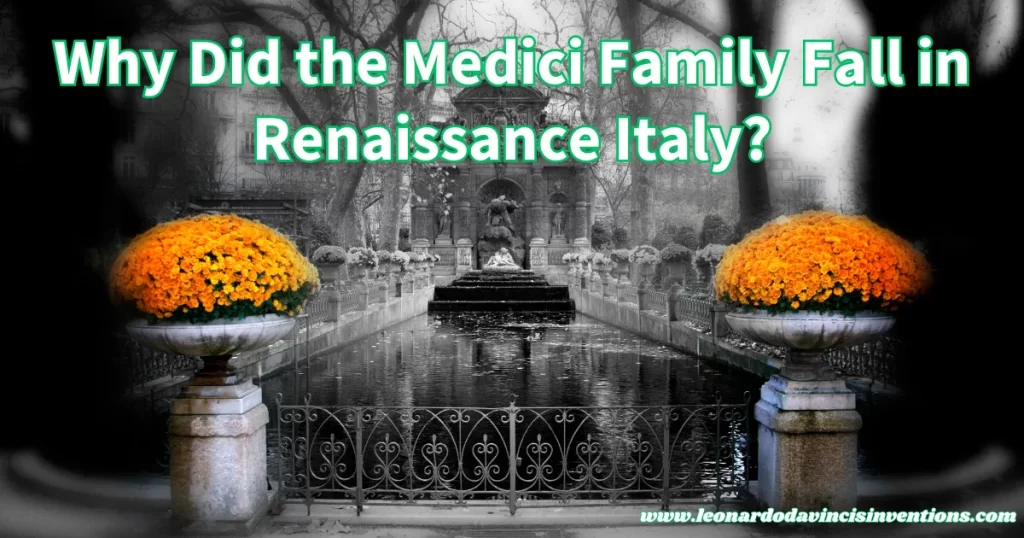
Why did the Medici family fall? This question has puzzled historians and lovers of Renaissance Italy for centuries.
You are not alone if you have ever wondered how a once-rich and powerful family could lose everything.
The Medici family’s fall resulted from financial troubles, shifting politics, and a loss of influence in Florence.
Their story includes drama, rivalry, and surprising twists that shaped Italian history.
The Rise and Decline of the Medici Dynasty in Florence
The Medici family started as powerful bankers and rose to rule Florence. They shaped the city’s politics, economy, and culture through their banking empire.
Their decline began with financial mismanagement, rivalry, weak leadership, and growing debt.
The Medici Banking Empire and Its Role in Political Power
The Medici built their wealth on a successful banking empire during the early Renaissance. Giovanni di Bicci de’ Medici founded the Medici Bank, making it one of Europe’s most influential banks by managing accounts for the Papacy and other powerful clients.
This financial success gave the Medici political power in Florence. They used their wealth to control government positions and form alliances.
The family sponsored the arts and supported artists like Michelangelo and Leonardo da Vinci, which boosted their prestige. As their power grew, the Medici moved from behind-the-scenes influencers to the de facto rulers of Florence.
Their roles as bankers, patrons, and statesmen gave them unmatched control over Florence and much of Italy.
How Wealth and Excessive Spending Led to Financial Mismanagement
The Medici spent heavily on palaces, art, festivals, and political schemes. This spending improved their reputation but strained the family’s finances and the bank’s solvency.
Over time, the Medici Bank faced unpaid loans and risky investments. They gave too much credit to monarchs and nobles who often did not repay, causing severe losses.
Financial mismanagement weakened the family’s core business. As debts grew, the Medici lost the economic strength that had made them powerful.
By the late 17th century, the dynasty faced bankruptcy under Cosimo III de’ Medici, making it difficult to maintain their influence and patronage.
Rival Families and Political Instability in Renaissance Florence
Other powerful families in Florence, such as the Pazzi and Strozzi, competed for political control. This led to constant power struggles and conspiracies.
The famous Pazzi Conspiracy, which began in 1478, tried to assassinate Lorenzo de’ Medici and end Medici rule. These rivalries created ongoing political instability in Florence.
The Medici’s enemies sometimes joined with outside forces or the papacy to reduce Medici influence. At times, the Medici faced exile and had to fight for restoration, using violence or outside help.
Frequent changes in the political climate weakened the Medici’s hold over government and public opinion. When rival families took key positions, the Medici’s monopoly eroded, and they lost control over Florence.
Leadership Failures and Succession Issues Within the Medici Family
Strong early leaders like Cosimo the Elder and Lorenzo the Magnificent helped the Medici maintain power and guide Florence to prosperity. Later generations faced succession issues and frequent leadership failures.
Some rulers lacked political skill or could not handle family conflicts. Others spent lavishly without considering the family’s finances.
Disputes over inheritance and leadership further divided the dynasty. Without strong direction, the Medici struggled to manage crises.
Their reputation for good governance faded, and stability disappeared. Leadership failures and internal disputes left the family open to threats from inside and outside.
The Impact of Economic Crisis and Debt on the Medici Decline
As Europe faced economic hardship and wars, borrowing costs increased, and trade slowed. The Medici faced mounting debt as their banking empire lost business, government incomes shrank, and their ability to collect taxes in Florence declined.
Economic crises hit during periods of weak leadership, exacerbated by financial mismanagement. The Medici had to sell assets and property to pay debts, reducing their land and wealth.
Social unrest grew as Florentine citizens became unhappy with high taxes and lost trust in the Medici rulers.
Political and Social Factors Behind the Medici Fall
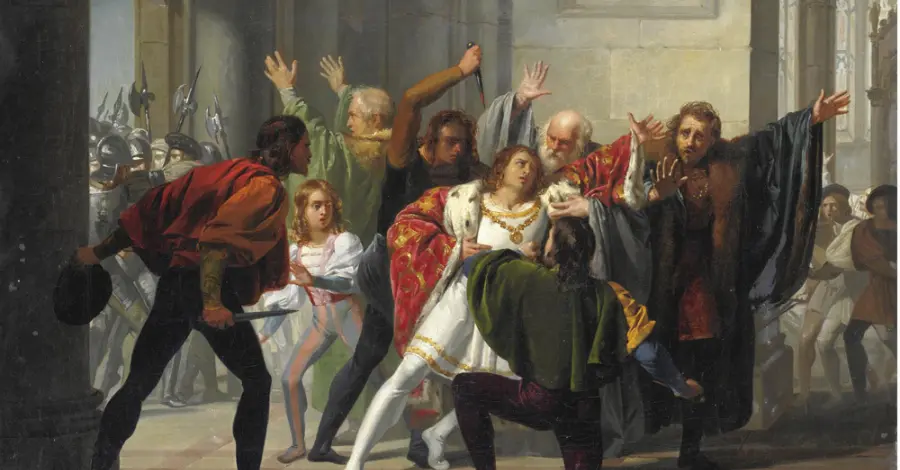
The Medici family’s decline involved corruption, factional fighting, outside pressure from the church, and growing social unrest. The weakening of their banking empire and the complicated politics of Florence added to the dynasty’s troubles.
Corruption and Power Struggles Among Medici Rulers
Corruption and internal conflict significantly weakened the Medici dynasty. Many years later, the Medici rulers focused on growing their wealth and power, often ignoring Florence’s needs.
Accusations of bribery, favoritism, and financial mismanagement increased. Frequent disputes over succession split the family into rival branches.
These succession issues led to instability and reduced public trust in Medici leadership. As corruption grew, other wealthy Florentine families began challenging their control.
These power struggles hurt the Medici’s ability to rule effectively. The focus on their interests over those of the city pushed Florence toward political instability and decline.
Influence of the Papacy and Medici Popes on Family Governance
The Medici family’s close ties to the papacy brought benefits and risks. Two Medici rulers, Leo X and Clement VII, became popes.
Their time as Medici popes increased the family’s influence in Europe and gave them direct control over church policy and finances. However, these connections also led to excessive spending to support the Vatican and maintain Rome’s luxury.
This contributed to debt and strained the Medici’s banking empire. Family control of both secular and religious spheres led to resentment from rival families and local leaders, who saw the Medici as overreaching.
The focus on papal concerns distracted Medici rulers from governing Florence. In times of crisis, leaders often favored church or personal interests instead of the city.
Religious Conflicts and Social Unrest During the Medici Era
Religious conflicts during the Renaissance weakened Medici power. Periods of reform and the rise of movements like Savonarola’s in Florence led to social unrest and demands for change.
The Medici faced public backlash when accused of suppressing reformers or ignoring church corruption. Popular figures such as Savonarola gained power and pushed for the Medici rulers’ exile.
This unrest fueled revolts against Medici authority, making it hard to create lasting stability. Religious division, often mixed with economic hardship, amplified protests and damaged their leadership reputation.
Political Alliances, Rivalry, and the Fall from Power
Rival families and political alliances shaped the Medici rise and fall. Groups such as the Albizzi and Pazzi families challenged Medici control and sparked plots to remove them from leadership.
Some alliances shifted quickly, making it hard for the Medici to count on support in Florence or abroad. After losing support from key allies, the Medici faced repeated periods of exile and restoration attempts.
Family disputes increased after failed alliances, leading to more infighting. Their enemies took advantage of these moments of weakness to seize power.
Without strong, lasting alliances, the Medici could not keep the Florentine Republic under their rule.
Public Opinion, Nobility, and the Loss of Control Over Florence
Public opinion and the attitude of the nobility deeply affected Medici fortunes. Early on, the family gained influence through the patronage system and by sponsoring art and learning.
Over time, popular support faded as taxes rose and the effects of the economic crisis became clear. Florence’s nobility and business leaders blamed financial decline and social unrest on Medici leadership failures.
As the banking collapse deepened, leaders lost the ability to win back public confidence. Crowds demanded change or even the restoration of the Florence Republic.
Without strong support from the people and nobility, the Medici dynasty could not survive the final challenges to their power.
Legacy, Cultural Impact, and Attempts at Restoration
The Medici family’s decline left a lasting mark on Florence and nearby regions. Their support for art, clashes with rival families, and efforts to regain power changed their dynasty and Renaissance Europe.
Patronage of the Arts and the Sponsorship System in Renaissance Italy
The Medici family transformed Florence into a cultural center by funding the work of great artists, architects, and scholars. Their patronage of the arts, known as the sponsorship system, led to the rise of talents like Leonardo da Vinci, Michelangelo, and Botticelli.
They used the wealth from their banking empire to commission works that still define the Renaissance. The Medici saw cultural spending as a mark of status and a tool of political power.
They also supported churches, universities, and public buildings, making Florence a beacon of art and learning.
The Medici Family Branches and Their Influence in Europe
The Medici dynasty was not limited to Florence. Different branches of the Medici family spread throughout Italy and later across Europe, marrying into noble houses and even royalty.
These connections increased their influence in Rome, France, and England. Several Medici became powerful figures in the Catholic Church, including Medici popes such as Leo X and Clement VII.
Their extended family affected art, finance, politics, and religion well beyond their original domains.
Family Disputes, Exile, and Political Decline of the Medici Dynasty
Internal family disputes and power struggles weakened the unity of the Medici rulers. The dynasty faced succession issues and leadership failures after key leaders died or went into exile.
Rival families and shifting alliances made the family’s hold on Florence more fragile. Repeated exiles during public unrest and social instability led to a decline in the Medici’s direct power.
Reformers like Savonarola and republican forces sometimes drove the Medici from power. The family would later return, starting a cycle of restoration attempts and a fall from power.
The Florence Republic and the Political Ruin of the Medici
The Florence Republic replaced Medici rule after repeated political ruin. The family lost control over governance and faced opposition from the population and the nobility.
Their harsh rule, high taxes, and financial mismanagement increased resistance. Anti-Medici sentiment grew as banking crises and war debt mounted.
This economic decline and pressures from the Papacy and other European powers pushed the Medici further down. The fall of the banking empire signaled the loss of control over Florence’s political system.
Legacy and Cultural Impact of the Medici Despite Their Fall
Even after their decline, the Medici left a lasting legacy and cultural impact on Florence and Europe. Their art sponsorship created world-famous buildings and works of art.
The family’s support of art and learning continues to shape European culture. Museums, churches, and universities in Florence show what the Medici accomplished.
Despite debt and rivalry, the legacy of their innovations and taste in art still attracts admiration worldwide.
Frequently Asked Questions
The Medici family’s rule in Florence ended due to political conflicts, poor leadership, changing alliances, and loss of power. Their legacy is connected to banking, art patronage, and controversy during the Italian Renaissance.
What caused the Medici downfall?
Rival families in Florence, such as the Albizzi, challenged the Medici’s rule. Weak later rulers and poor financial decisions hurt the family’s stability.
Foreign invasions and shifting alliances also weakened their control.
What brought down the Medici family?
The Medici failed to adapt to changing political climates. The rise of new powers in Italy and Europe, such as Spain and France, put pressure on Florence.
Popular uprisings in Florence drove them out more than once and reduced their influence over time.
Why did the Medici bloodline end?
The Medici bloodline ended because their last direct heirs had no children. The last surviving member, Anna Maria Ludovica de’ Medici, died in 1743.
Without surviving children or close family to inherit, the Medici dynasty’s line ended.
Why was the Medici family corrupt?
Many people accused the Medici of using their wealth to buy power and control in Florence. Their banking business sometimes led to unfair practices.
The family’s involvement in politics, bribery, and manipulation led to corruption charges by rivals and critics.
Are there still Medicis today?
No direct descendants of the famous Medici rulers remain. Some distant relatives may exist, but no influential Medici family exists in Italy today.
The dynasty’s line officially ended in the 18th century.
Who betrayed the Medici family?
Several people turned against the Medici, but one famous betrayal involved members of the Pazzi family. In 1478, the Pazzi Conspiracy tried to kill Lorenzo de’ Medici and his brother Giuliano.
Other political rivals also betrayed them in later years.
Why did Italy hate the Medicis?
Some Italians disliked the Medici for acting as tyrants and interfering in Florence’s government. Rivals accused them of greed and abusing their financial power.
Their strong ties with the Catholic Church and use of force created more enemies among the people and nobles.
What is the oldest bank in the world?
Banco di Monte dei Paschi di Siena, founded in 1472, is considered the oldest bank still in business. The Medici Bank, though famous and influential, no longer exists.
More details can be found on the banking history in Italy at the House of Medici.
Did the Medici family go broke?
The Medici bank collapsed due to poor management, bad loans, and risky ventures. The family’s loss of its banking fortune weakened its power.
By the time the last Medici rulers died, most of their wealth had disappeared.
Who ruled Florence after the Medici?
After the Medici family fell, Austria took control of Florence.
In the 19th century, Florence became part of the Kingdom of Italy.
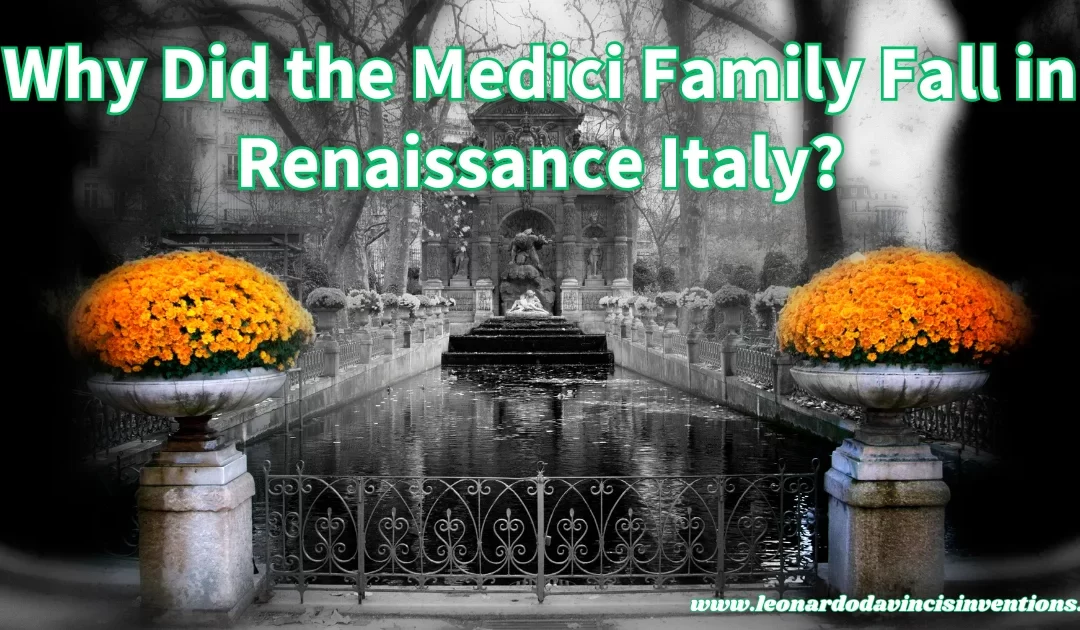
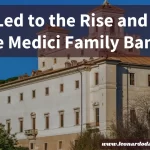
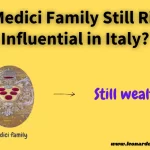
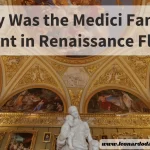
 Leonardo Bianchi,
the creator of Leonardo da Vinci's Inventions.
Thank you for visiting
Leonardo Bianchi,
the creator of Leonardo da Vinci's Inventions.
Thank you for visiting